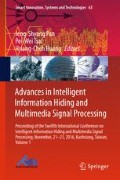Abstract
Understanding the mechanism related to how people perceive reality is crucially important for the development of high-definition communication systems in multimedia contents. Various sensory information is well known to affect perceived reality from multimodal contents. For this purpose, it is important to present multimodal information with proper timing. This study investigated temporal characteristics of perceived reality induced by multimodal contents including vibration information. Results indicate that temporal characteristics of perceived reality depended on the timing of the events in the content, e.g. the timing with which the train just passes through an observation point. Moreover, the sense of presence was more sensitive to the timing of the presentation of sensory information with long contents.
Access this chapter
Tax calculation will be finalised at checkout
Purchases are for personal use only
Preview
Unable to display preview. Download preview PDF.
References
Abe K., Ozawa K., Suzuki Y., Sone T.: Comparison of the effects of verbal versus visual information about sound sources on the perception of environmental sounds. Acta Acustica united with Acustica 92, 51–61 (2006)
Honda A., Kanda T., Shibata H., Asai N., Teramoto W., Sakamoto S., Iwaya Y., Suzuki Y., Gyoba J.: Determinants of senses of presence and verisimilitude in audio-visual contents. Journal of the Virtual Reality Society of Japan 18(1), 93–101 (2013) (in Japanese)
Kim S., Sakanashi H., Martens W.L.: Multimodal representation of electronic piano sound for pianoplayers. In: INTER-NOISE 2011, 6-page manuscript (2011)
Meyer G.F., Wang L.T., Timson E., Perfect P.: White MD Objective fidelity evaluation in multisensory virtual environments: Auditory cue fidelity in flight simulation. PLoS One 7(9), e44381 (2012)
Sakamoto S., Hasegawa G., Honda A., Iwaya Y., Suzuki Y., Gyoba J.: Body vibration effects on perceived reality with multi-modal contents. ITE Trans. on MTA 2(1), 46–50 (2014)
Slater M., Steed A., McCarthy J., Maringelli F.: The influence of body movement on subjective presence in virtual environments. Human Factors 40(3), 469–477 (1998)
Teramoto W., Yoshida K., Hidaka S., Asai N., Gyoba J., Sakamoto S., Iwaya Y., Suzuki Y.: Spatiotemporal characteristics responsible for high vraisemblance. Journal of the Virtual Reality Society of Japan 15(3), 483–486 (2010) (in Japanese)
Teramoto W., Yoshida K., Asai N., Hidaka S., Gyoba J., Suzuki Y.: What is “sense of presence”? A nonresearcher’s understanding of sense of presence. Journal of the Virtual Reality Society of Japan 15(1), 7–16 (2010) (in Japanese)
Tato T., Namba S., Kuwano S.: Continuous judgment of level-fluctuating noise, In: INTERNOISE 94, pp. 1081–1084 (1994)
Witmer B.G., Singer M.J.: Measuring presence in virtual environments: A presence questionnaire. Presence 7(3), 225–240 (1998)
Woszczyk W., Cooperstock J., Roston J., Martens W.L.: Shake, rattle, and roll: Getting immersed in multisensory, interactive music via broadband networks. J. Audio Eng. Soc. 53, 336–344 (2005)
Yagyu H., Cui Z., Sakamoto S., Ohtani T., Suzuki Y., Gyoba J.: Effects of multimodal contents on the temporal shifts in reality perception. Journal of the Virtual Reality Society of Japan 20(3), pp. 199–208 (2015) (in Japanese)
Author information
Authors and Affiliations
Corresponding author
Editor information
Editors and Affiliations
Rights and permissions
Copyright information
© 2017 Springer International Publishing AG
About this paper
Cite this paper
Sakamoto, S., Yagyu, H., Cui, Z., Ohtani, T., Suzuki, Y., Gyoba, J. (2017). Temporal characteristics of perceived reality of multimodal contents. In: Pan, JS., Tsai, PW., Huang, HC. (eds) Advances in Intelligent Information Hiding and Multimedia Signal Processing. Smart Innovation, Systems and Technologies, vol 63. Springer, Cham. https://doi.org/10.1007/978-3-319-50209-0_25
Download citation
DOI: https://doi.org/10.1007/978-3-319-50209-0_25
Published:
Publisher Name: Springer, Cham
Print ISBN: 978-3-319-50208-3
Online ISBN: 978-3-319-50209-0
eBook Packages: EngineeringEngineering (R0)

